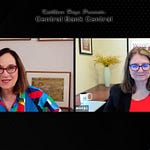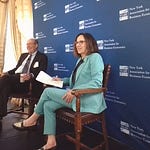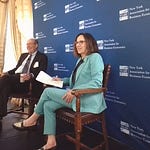John Taylor is an Economics Legend. How many others have created a guiding monetary policy star for central bankers around the world, from the Federal Reserve, to two of the earliest inflation targeters, the Reserve Bank of New Zealand, and the Bangko Sentral Ng Pilipinas? It’s a formula for using a central bank’s inflation target vs the country’s actual inflation rate, and a measurement of actual economic growth vs estimates of potential GDP to come up with a number that tells the policymakers what they need to do on interest rates, i.e. cut rates, hike them, or leave them unchanged?
Central bankers love to quote Milton Friedman on monetary policy, but when it comes to taking action, they are more likely to follow John Taylor’s rule.
The Taylor Rule defines how most central bankers conduct monetary policy in the 21st century. The idea is to provide a guide post, an estimated North Star, to help policymakers gauge when they are on track to hitting a 2% inflation target, or if further policy adjustments are needed to get there.
It potentially gives a platform, a benchmark, against which central bankers can weigh their “discretionary” policy decisions vs an objective calculation of what is needed to maintain what Alan Greenspan heralded years ago as Price Stability.
A weaker-than-expected U.S. July jobs report fueled talk of the U.S. on verge of recession or maybe already in one, and set off big drops in stock prices, bond yields, gold prices, and the U.S dollar. It inflamed investors (long-held and hoped for bets on Fed rate cuts, starting in September. Some big U.S. banks and investment house economists are now predicting that the Fed will kick off its rate hiking cycle with a 50 bps rate hike at that meeting, and do at least one more of this size and a 25bp add-on by the end of the year.
John Taylor has little to say about that and what it means for the size and speed of rate cuts. Reporters peppered Fed Chair Jay Powell with repeated questions about the labor market at the press conference after the Fed’s policy meeting last week. And Powell repeatedly talked about the Fed’s dual mandate, its need to not only push inflation back to its 2% target but also to make sure it doesn’t let the labor market weaken too much.
So I asked Professor Taylor what signals the jobs report are sending to the Fed in terms of the need to cut rates. “Well it’s a little bit of a doubt, unemployment is up a little bit (more in July) but that’s okay. It still has a ways to go,” he says.
”But the main thing is to think about is what the target inflation rate should be,” he adds. “There’s been a lot of discussion about that, a 2% target. It’s not just the Fed, it’s other countries as well.”
”So I think the hope is that we’ll be glued to a more appropriate monetary policy rule,”
Bottom line, what is the Taylor Rule saying about how low the fed funds rate need to go?
”Remember the target of the inflation rate is 2%. Don’t forget that,” he says. “Jay Powell mentioned it several times,” he adds. “Once you have that, what should the real rate be? Should it be 2%, 3%? I think 2% is good, so two plus two is 4%,“ for what the Taylor Rules says is the correct level for the fed funds rate now.
Markets once again are off on a wild goose chase for bigger rate cuts and more of them: the Taylor Rule brings all that back to earth and into focus.
So see and hear what Professor Taylor himself has to say.
This is a really good read from the Hoover Institution itself:
Taylor’s Rule
https://www.hoover.org/research/taylors-rule
And here’s who is and how he got here
John B. Taylor is the George P. Shultz Senior Fellow in Economics at the Hoover Institution and the Mary and Robert Raymond Professor of Economics at Stanford University. He chairs the Hoover Working Group on Economic Policy, co-chairs the Hoover Technology, Economics and Governance Working Group, and is director of Stanford’s Introductory Economics Center.
Taylor's fields of expertise are monetary policy, fiscal policy, and international economics. His book Getting Off Track was one of the first on the financial crisis; his latest book, First Principles, for which he received the 2012 Hayek Prize, develops an economic plan to restore America’s prosperity. His most recent book is Choose Economic Freedom: Enduring Policy Lessons from the 1970s and 1980s with George P. Shultz.
Taylor served as senior economist on President Ford's and President Carter’s Council of Economic Advisers, as a member of President George H. W. Bush's Council of Economic Advisers, and as a senior economic adviser to Bob Dole’s presidential campaign, to George W. Bush’s presidential campaign in 2000, and to John McCain’s presidential campaign. He was a member of the Congressional Budget Office's Panel of Economic Advisers from 1995 to 2001. From 2001 to 2005, Taylor served as undersecretary of the Treasury for international affairs where he was responsible for currency markets, international development, for oversight of the International Monetary Fund and the World Bank, and for coordinating policy with the G-7 and G-20.
Taylor received the Bradley Prize from the Bradley Foundation and the Adam Smith Award as well as the Adolph G. Abramson Award from the National Association for Business Economics. He was awarded the Alexander Hamilton Award for his overall leadership at the US Treasury, the Treasury Distinguished Service Award for designing and implementing the currency reforms in Iraq, and the Medal of the Republic of Uruguay for his work in resolving the 2002 financial crisis. At Stanford he was awarded the George P. Shultz Distinguished Public Service Award, as well as the Hoagland Prize and the Rhodes Prize for excellence in undergraduate teaching. He is a fellow of the American Academy of Arts and Sciences and the Econometric Society; he formerly served as vice president of the American Economic Association.
Read More













Share this post